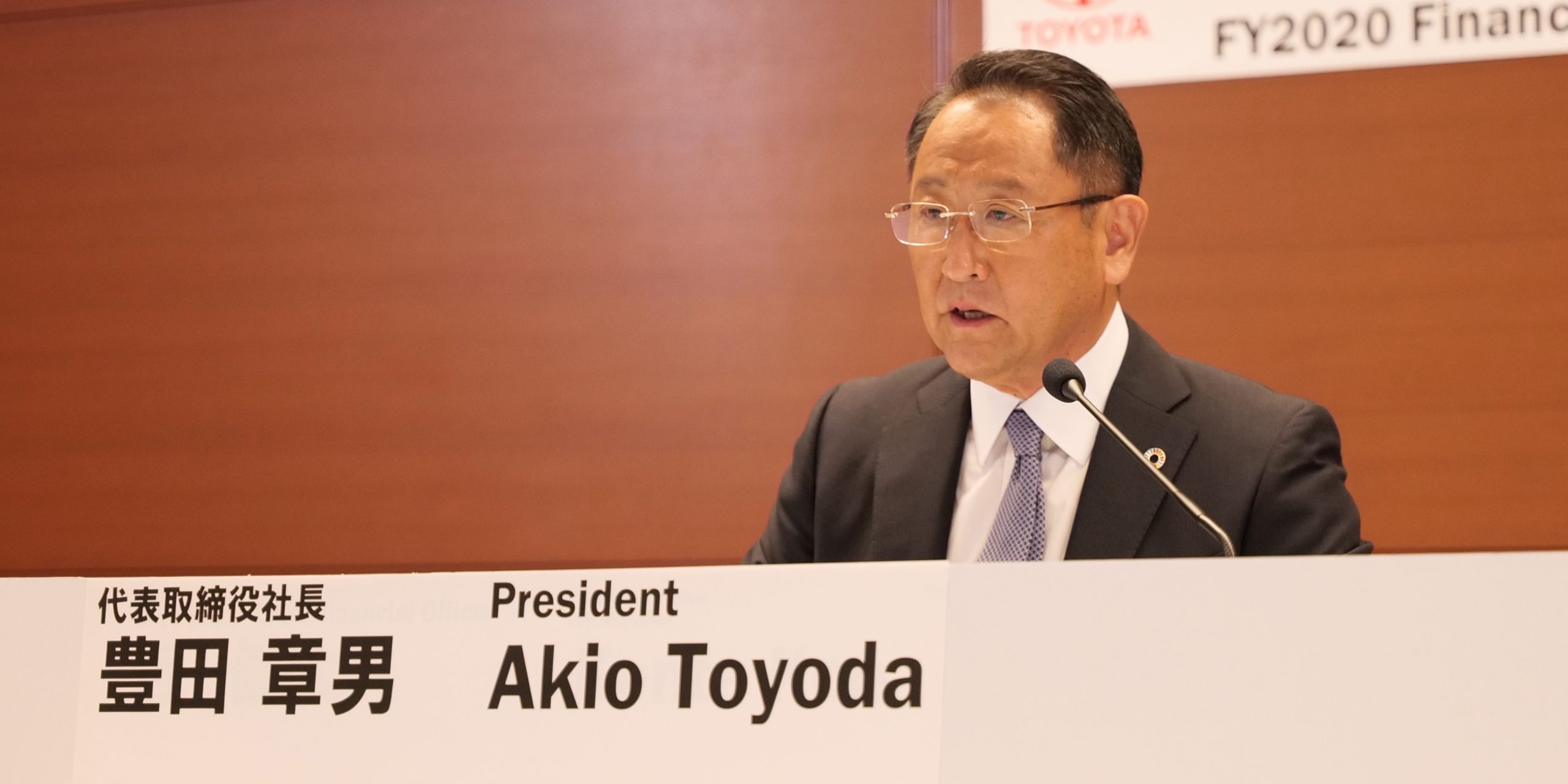
Keep calm and manage stably: Akio Toyoda on crises
FEATURE – Akio Toyoda’s May 12th press conference to present Toyota’s financial results offers great insights into how the company is reacting to the pandemic, say Jeff Liker and John Shook.
Words: Jeff Liker, Emeritus Professor at the University of Michigan, and John Shook, Chairman of the Lean Global Network.
Photo comes from the Toyota Newsroom and is approved for editorial use.
When we read the article, Lockdown Leads Toyota Chief to Question Core Tenet for Carmaker (Bloomberg May 13), we were surprised, even a bit concerned. Questioning “long-ingrained practices” is a good thing, but it can easily lead to misinterpretation – and it certainly did in this case. The core tenet in question was genchi genbutsu, one of the five foundational principles of the Toyota Way. So, we read Akio Toyoda’s actual words and it did not take long to realize he was talking about something far deeper than reported in the articles we saw. In fact, the way President Toyota answered the questions from journalists and stock analysts reflected long-standing core principles of Toyota Way and lean thinking.
TPS is often misunderstood. Just-in-Time is regularly blamed for supply chain disruptions, for example, even though the current long, slow-to-react supply chains that stretch the globe are the opposite of JIT. Similarly, we see consultant-led cost-cutting initiatives being called “lean programs” time and time again. It appears there is an appeal to throwing out the old principles, methods, or people and bringing in the new. This is why we decided to share our interpretation.
We were not surprised by Akio Toyoda’s challenge to rethink practices, but by the passion and candor displayed in public, bringing classic Toyota thinking to the fore in the midst of the current pandemic.
The occasion was the May 12 press conference in Tokyo where Toyota was presenting its financial results for the year ended March 31, 2020. These annual presentations are unfailingly boring affairs (a fact to which John can testify from painful experience). This year’s presentations themselves were quite interesting – and revealed a worsened year-on-year financial performance. The formal presentation was followed by a Q&A session where the journalists posed some interesting questions to which Akio offered some remarkably candid and insightful replies.
GENCHI GENBUTSU AND GEMBA REVISITED
Genchi genbutsu means “the actual place”, “the actual thing”. The idea of going to the gemba is common in lean parlance, but the deeper meaning is to study first-hand what is happening to fully grasp the situation and understand why things are as they are and the causes of any problems or need for ongoing improvement or innovation. For example, if a defect is created in a machine, go to the machine and study its condition and investigate the actual part that failed. Toyota people and lean practitioners everywhere have certainly held a strong bias toward being physically present, as in standing in the Ohno circle, but the process of how you get facts and grasp the situation is secondary. The principle is to confirm what’s really happening. The meaning was never that a company CEO must literally go to each gemba each time something goes wrong or to confirm the results of each improvement trial. The same is true of gemba’s matched pair of the 5 whys. The point is not to literally ask why five times; what’s important is to pursue understanding of causality. And as for how to understand causality, use the simplest means possible, starting with the 5 whys. When you need more than simply asking why a few times, that’s the time to reach into the toolbox for your more sophisticated analytical tools (SPC or six-sigma tools, for example).
As is true for us all, with Covid-19 Akio Toyoda has been forced to do a lot more communication and “go see” via virtual means, leading to personal learning that he shared during the Q&A session. Traditionally, in Japan face-to-face communication is considered respectful and we all know that practically speaking it provides better access to non-verbal cues. But Akio shared that he has found some benefits to virtual meetings: by staying in Toyota City, “I have reduced 80% of my travel time, also 85% the number of people I meet, 30% of time in meetings and 50% of the documents that was prepared for meetings.”
These comments are hardly surprising: Akio Toyoda has been pushing Toyota into the new era of CASE (where cars are Connected, Autonomous, Shared and Electric) and more robust use of digital tools. But he explored further, recognizing that there is still indispensable value in going to the actual place – a core tenet of all work at Toyota. When asked what he wants to protect in this time of once-in-a-century transformation of the mobility industry, where there is radical change, he replied:

"We have a 'genba' or frontline where work gets done. That genba is real, and what we have been able to cultivate in our genba over these many years is something that no digitization or telework system, no matter how advanced they become, can ever replace in the real world. It is the real world where people have work to do, doing the work only people can, and where Toyota people capable of further kaizen or improvement are trained. With this ability to improve, I would like to make Toyota into a company that all people can have high expectations from into the future."
But the question remains – when is it okay to use virtual means and when is it still necessary and worth the effort to literally go to the gemba? Here, Akio was circumspect, indicating he wants to push the culture to be more open to other approaches to go about grasping current conditions and to clarify what genchi genbutsu means in these new conditions by asking why. He said:
“For Toyota’s ‘genchi genbutsu’ philosophy, going to the actual site, looking at the actual goods, I believe that we have to make a clear definition of this once again. Up to now, we placed importance on, first of all, going to the actual site, go to the “genchi”, and it was done as a matter of course. Even if we look at products, we will always have to look at the actual product and place it in front of our own eyes. No one questioned this philosophy up to now. But in the past month, we have been looking at products more through images on monitors. I think at certain stages, it is fine to see the product on the monitor but there will always be times that you will have to see the actual product. Some things can only be felt when you are at the gemba. So, for those kinds of things where you need to feel the actual products, the actual people, then that should be done at the actual site. I think we should not just say we do ‘genchi genbutsu’ everywhere, but we need to clarify under what conditions it is necessary to actually go see.”
Far from denying the value of genchi gembutsu, Akio was affirming its value even in today’s conditions, while questioning the means by which it is most effectively accomplished. Such questioning represents classic thinking regarding innovation at Toyota – begin from need.
LONG-TERM THINKING, LONG-TERM INVESTING
The financial data presented revealed a forecast of an 80% reduction in profits. Many companies are experiencing similar downturns with many issuing a call to crisis, calling out guilty parties to fire, issuing mass layoffs, and retrenching from planned investments. Akio and his team presented the information dispassionately – facts are facts. Given the pandemic, it is understandable that profits will be reduced but there is a deeper reason this is less of a crisis in Toyota’s situation. It has to do with the way the company views money. The basics are: save for a rainy day and do not depend on large loans from other institutions that may try to control decisions.

Late in 2019, Toyota had over $50 billion in cash or cash equivalents, the most in its history. The company has made record profits for the auto industry as a whole of near or over $20 billion annually for five years running. Cumulatively, since Jeff published The Toyota Way, Toyota has earned about $180 billion, more than the sum of GM, Ford, Volkswagen, and Honda combined. It has experienced an annual financial loss twice in its 80-year history. One “bad year” of earning – say, only $5 billion – does pretty minimal damage to financial health. It is a situation to take seriously and tackle in earnest, but it is no reason to panic, thereby inflecting unnecessary waves of turbulence throughout the enterprise.
Second, thinking long-term has always shaped Toyota’s purpose, which begins with the commitment to contribute positively to society, benefit customers, employees, associated businesses. Doing all this requires developing capability to create enough value at low-enough cost to generate enough return to be profitable, but profit is not the purpose. One reporter noted that despite the lower profits the budget for R&D had not been cut, to which Akio and his team responded:
“We are now making Toyota a new Toyota. We have started to plant the seeds to sow the new Toyota. For these kinds of new projects, we will continue to push the accelerator pedal.”
Toyota’s Chief Risk Officer, Koji Kobayashi, added:
“We cannot stop investment in the future. This is one of the things that you have to continue forever, and it has to be supported with proper funding. At the time of the Great Recession, we had JPY3 trillion cash on hand. Today, we have JPY8 trillion cash on hand. This is still smaller than we’d like; Apple, for example, has JPY20 trillion. All companies experience ups and downs, of course, but expenditures in the future will be necessary to fund continued growth while ensuring we also continue to contribute to society. You mentioned the Woven City project and R&D investment; commitment to these kinds of investments will never be changed. However, I am keeping a keen eye on spending. If I see any wasteful spending, I will cut it.”
BE CALM AND THOUGHTFUL IN A CRISIS, DON’T PANIC – MANAGE STABLY
When asked how his learning from previous crises is contributing to his handling of the Covid-19 one, Akio turned introspective:
“The number one thing I have learned and that I am prioritizing from my learning is that I am not panicking. I am managing the company very efficiently and stably. In managing the company during these past 10 years, no years were peaceful. Every year, year on year, we have witnessed and experienced a large, drastic change on the scale of a one-in-a-100-year event. So, I think that the calmer I am, the calmer things are within the company.”
There will always be a “next crisis” – we just don’t know what it will be and when it will appear. It is by recognizing this that Akio emphasizes the importance of managing stably, without panic, even when novel approaches are called for and innovation is more necessary than ever. This connection between the yin and yang of stability and innovation is a vital source of Toyota’s enduring strength.
Akio continued, sharing his feeling that he was not well accepted when he first became president - “almost no one inside or outside the company seemed very happy that I was made president.” But over 10 years of showing the way through these crises he has been accepted. He recalled he became president in the midst of the Great Recession, when Toyota for the first time in 50 years experienced an annual financial loss. That was followed by the recall crisis, the Japan earthquake and Fukushima nuclear power plant meltdown, and the worst flooding in Thailand’s history (which disrupted not only vehicle production in Thailand, but also the supply of many parts and materials to Japan). In the face of each of these threats, Toyota was still profitable. Rather than express bitterness about some initial skepticism when he was named president, Akio effused gratitude to those individuals who gave him a chance and helped bring the company back to a strong position:

“Especially now, as I meet with and encounter those employees, I feel like I am having increased opportunities to say ‘Thank you’ to them. I think the company is rather stable now, not panicking at all. We are making profit and we can make investments for the future. We can continue to invest in advanced R&D. We have good internal communication by which we are able to say thank you to each other in the company. So, to show the appreciation to each other in the company means that people in the company are working for, not only themselves, but for the other people more than themselves. This should not change at all.”
Asked about current priorities for the company, Akio connected the Covid-19 crisis and the once-in-a-century transformation of the automobile industry, invoking core values the company has long espoused:
“As for the immediate crisis, the priorities are the same we always have at Toyota: first safety, second quality, third volume, and fourth profit-making. As times change, these priorities may need to be revisited. But, in the midst of this crisis, our traditional prioritization has continued to be very important. And based upon these priorities, we will try to develop the Toyota people, and this is also very important.”
Asked directly what the biggest challenge facing Toyota today is, Akio closed the session by returning to his desire simply to say “thank you” more:
“Last year, I said that the threat for Toyota is thinking that Toyota is alright. As for this new threat (Covid-19) I would say is that… well, rather than fearing it as a threat, for myself, I am currently staying very calm. I can see so many people in the company making their upmost efforts. That gives me many welcome opportunities to say thank you to the people around me. [...] When the opportunity for me to say thank you starts to disappear and when I start to complain to myself more often than I do now, that will be the time where I see more threats. So, including the way I work, I want to build stronger relationships inside the company and strengthen relationships with our suppliers and dealers. Also, I want to build on the relationships we have with our communities, so that I can say thank you to all these friends and partners. [...] So rather than be fearful of the threat, I want to stress the positive expectations that I have.”
So, recognizing that giving thanks inspires humility in the giver and motivation in the receiver, as his top priority in navigating the Covid-19 crisis, Akio cites “frequency of saying thank you”! How many executive dashboards do you think would display that as a metric of the executive’s role and enterprise health?
OUR TAKEAWAYS

In Akio’s remarks, it is easy to see living evidence of the thinking, principles, and practices that have guided Toyota through its decades-long run of success: practice genchi gembutsu flexibly; don’t panic, keep calm, manage stably (we could make a t-shirt - "Keep Calm and Manage Stably") and continue to invest for the long-term; be thankful, be humble, show your appreciation – continue to depend on and develop people.
It is unusual for remarks from a Tokyo financial results reporting session to be of much interest to anyone other than analysts and investors. It is extraordinary to hear an exchange that is so thoughtful, full of candor, and revealing of a leader speaking with confidence while at the same time divulging human vulnerability.
It will be interesting indeed to observe the interpretations of Akio’s remarks as they continue to seep out in the world. It will also be instructive to see how they unfold inside Toyota. Lean thinkers have always looked to Toyota for their reference model. No company can be Toyota – trying to simply incorporate Toyota’s technical methods out of context continues to confound organizational transformation attempts in every sector. But lessons afforded from studying the company abound today as well as ever. For us, Akio Toyoda’s remarks reaffirmed the remarkable nature of the company, leaving us with confidence that Toyota will continue to serve as an inspiration, even as the world continues to change in unpredictable ways.
For an updated view of Toyota’s principles in action and how it is showing the way into the future look forward to: Jeffrey Liker, The Toyota Way, Second Edition, to be available in October of 2020.
THE AUTHORS


Read more


INTERVIEW – We speak with the National Petroleum Construction Company in the Emirates, learning how improving one of their critical processes is boosting the spread of lean thinking across the business.


FEATURE – In part 2 of his article, the author unveils an improved process that allows this Hungarian company to replace machine parts with minimal production downtime.


FEATURE – To really embrace lean thinking means to ensure the bureaucratic structures in our organizations enable our people to excel, rather than constrain their creativity.


FEATURE – This article applauds the tenacity of women leaders and seeks to illustrate how they motivate others to take on the sustainability challenge through lean practices.

